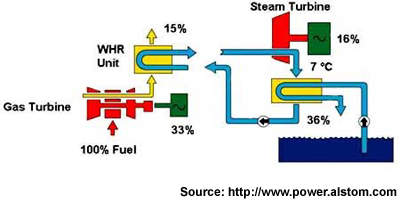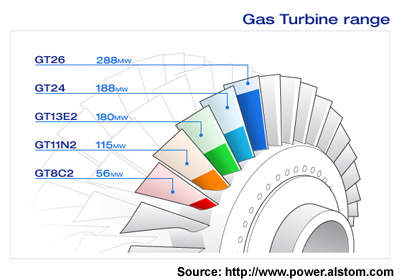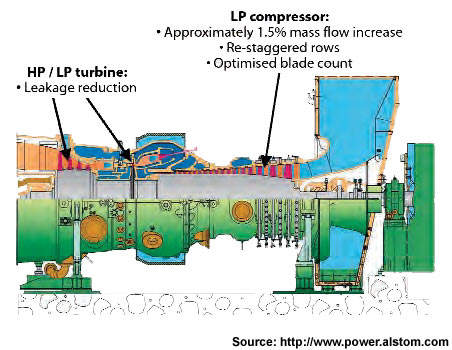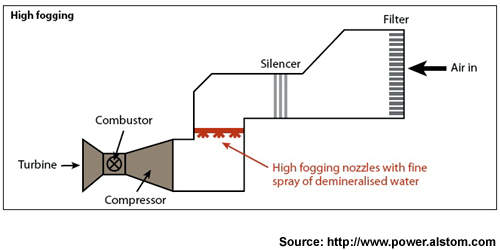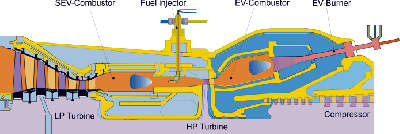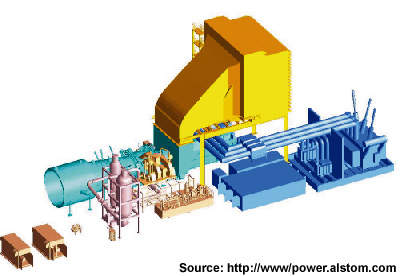Ireland’s largest power station, Aghada 435MW Combined-Cycle Power Plant, was opened on 31 May 2010 after upgrading the existing four 430MW generating units. The plant’s installed capacity has now increased to 963MW. The four units now generate 528MW. Construction began in October 2007.
Alstom built the 430MW combined-cycle power plant for ESB Power Generation at Aghada, Ireland. The plant uses Alstom’s GT26 gas turbine with a low-NOx Environmental (EV) burner.
This contract was the second GT26-based contract signed by ESB, following the Synergen plant at Ringsend (Dublin), which went into commercial operation in 2002. The new plant is part of ESB’s plan to renew its generation portfolio with a new more efficient plant.
There are 81 Alstom GT24/GT26 units in commercial operation worldwide and the fleet has accumulated more than 2.2 million firing hours.
The 50Hz GT26 can produce at 59% net efficiency, claimed as the best for a combined cycle plant in this class, and a significant step to 60% net plant efficiency with the existing engine.
Alstom provided all engineering, procurement and construction services for the plant, in Midleton, Co. Cork.
The turnkey order was valued at €275m,and financed by ESB Power Generation, a division of the Irish state-owned power producer Electricity Supply Board (ESB). After investing more than €75m, the project now costs €360m.
Intergrating operations
The plant uses a single KA26 single-shaft combined cycle unit and will integrate in-house core plant components built around Alstom’s GT26 gas turbine. It also has a compact reheat steam turbine and a hydrogen-cooled TOPGAS generator.
The new Alstom turbine optimises factors like availability, efficiency, power output and environmental emissions. The design uses sequential combustion and a robust, maintenance free, welded rotor design. It has a low-NOx EV burner, compact annular combustor and Egatrol GT controls.
The GT26 develops an electrical output of 288MW at an electrical efficiency of 38% and heat rate of 9,449kJ/kWh (all gross values). The turbine runs at 3000 rpm with a compressor pressure ratio of just under 34:1.
Exhaust gas flow is 650kg/s and exhaust gas temperature is 616 °C. NOx emissions (corresponding to 15% O2, dry) are well below 25 vppm.
The GT24/GT26 gas turbines are optimized for combined cycle.
They burn natural gas as a primary fuel and fuel oil as backup. The Combustion System allows a wide range of natural gas compositions to burn with higher Wobbe index fluctuations than other turbines. The GT24/GT26 can also burn natural gases with large high-hydrocarbon content.
Variable guide vanes
With three rows of variable guide vanes on the compressor, the engine has an exceptional turn down ratio. Exhaust gas temperature is maintained at the Heat Recovery Steam Generator (HRSG), so part-load efficiencies are higher than usual for this class of engine. The combination of sequential combustion and the EV burner gives the engine low emissions across a wide load range.
The GT24/GT26 can operate in all three major modes: base load, intermediate duty and daily start/stop. The turbines can work in both single- and multi-shaft arrangements. Engines have also been successfully used in re-powering applications.
Exhaust temperatures tuned for combined-cycle
The reheat process in sequential combustion provides optimum exhaust temperatures for combined-cycle use, the main application of the GT26. The two individually controlled combustor chambers of the GT26 sustain high efficiency and low emissions at part load by manipulating the air flow by three variable guide vanes. The vanes help cut air mass flow to 60% of full load level while maintaining the exhaust temperature.
This ensures that the thermodynamic quality of the sequential combustion combined-cycle remains nearly constant, maintaining its high live steam temperatures. As a result, GT26 system efficiency at 50% load, for example, is around 12% better than a conventional gas turbine combined-cycle power plant. NOx emissions corresponding to 15% dry oxygen are below 25 vppm.

